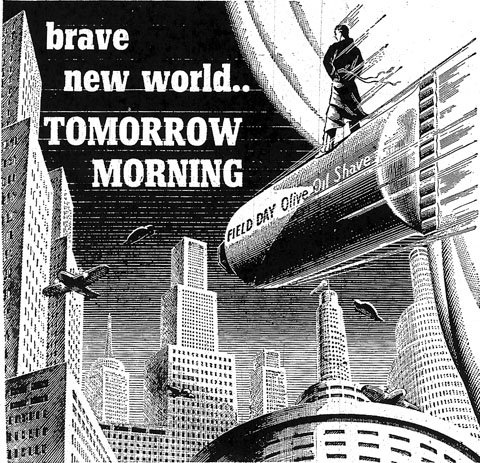
This sticker is in the back of a book published in 1940, originally part of the collection of the Public Lending Library of Victoria (itself a part of the Public Library of Victoria, as the SLV was then known). I was struck particularly by no. 4. Were books considered possible vectors for infectious disease — TB, perhaps? (If so, then obviously the best idea would be to get those books back into circulation as soon as possible.) Or maybe the Chief Librarian was worried that if everyone in the house was sick, their library books wouldn’t be returned on time, even despite the THREEPENCE fine for every three days or fraction thereof that they were overdue. (I can just imagine the Librarian glaring at the hapless late returner and spitting out the words “That will be THRUP. PENCE.”) I also like the way in which books are treated like people: they are not to be “detained” or “injured” (as a bibliophile, I’m always in danger of the former habit but completely agree with their firm stance on the latter). But I’m dying to know what Lending Library Rule 6 was. If there are any former patrons still around they could probably tell me — given the familiarity they were expected to have with the Lending Library Rules it’s probably burned into their minds. And can you imagine your embarrassment at waking up the day after moving house, and realising that you’ve neglected to notify the Librarian without delay?
From here, we can see that the reign of terror of Wm. C. Baud and C. A. McCallum, Chief Librarians, ended in 1960. We can be thankful that we live in more enlightened times: since August last year, I’ve accumulated $13.50 in overdue fines at the university library (about 5s in 1940s terms), and they don’t seem to care in the slightest. Viva la revolución!
![]() This work is licensed under a Creative Commons Attribution-NonCommercial-NoDerivatives 4.0 International License.
Permissions beyond the scope of this license may be available at http://airminded.org/copyright/.
This work is licensed under a Creative Commons Attribution-NonCommercial-NoDerivatives 4.0 International License.
Permissions beyond the scope of this license may be available at http://airminded.org/copyright/.





I’m dying to know what Lending Library Rule 6 was.
No poofters?
(OK, I’m leaving now …)
“Rule Six. There is no rule six”
I knew someone at Royal Holloway who managed to owe the library £72 in fines. I also remember that, as a lad in the 1980s, Bradford Metropolitan Council’s libraries were governed by a fearsome code stapled to the peeling, defunded walls that actually forbade you to laugh.
Alan: it was a humble library, not a philosophy department. I doubt it would have been anything so elevated!
Alex: well, you gotta laugh don’t you. Only outside the library though. Did you test the boundaries? Did they let you smirk? Snicker? Snigger? Chuckle? Giggle? I bet they drew the line at giggling.
One library on campus has signs explicitly prohibiting study. “Please do not study in this library” or something like that. (It’s the student union library, not an academic one.) Though I have seen people breaking this rule, to my knowledge they’ve never been forcibly ejected from the premises for doing so, which seems wrong somehow.
I seem to recall that just seeing the rules used to make me snigger.
It’s not such a stupid idea – you could lie in bed, sneezing on books, passing them on…
I seem to remember reading stickers in books that had been in libraries maintained by chemists that they promised the books were regularly fumigated.
i know this was a big panic in the fifties with polio.
Thanks, David. Yes, that’s not implausible. One would assume that the library didn’t just put the books back into circulation, that they treated them somehow, or quarantined them for some period. Maybe even just burned them. But as their otherwise stringent rules don’t seem to require informing them that there was a disease outbreak in the house — just to return the books — who knows what they actually did?
Would fumigation work against polio, anyway? A virus isn’t alive and so couldn’t be killed by gassing it, which (as I understand it) is what fumigation basically is. TB, I could see — that’s caused by bacteria which could in theory be gassed effectively. (I’m not a doctor or a biologist, so of course I could be wrong.) Of course, all this may not have been clear in the 1940s when the sticker was printed. Or maybe it was just a sop to public opinion. Any historians reading this? Oh … right.
Pingback: Barista » Blog Archive » History Carnival XLIV
Of course the Rowden White library is not for studying, Brett, it’s for learning all about modern music, developing networks with borrowing staff and organising a listening post of your own with a stack of CDs waiting for you when you come in. As one of my neighbours, an old Engineering stude, told me about ten years after I graduated. No wonder all I ever did there was have a kip in a leather chair. Only library on campus with footstools in 1979.
Oh yes, it was great for having a nap between, and sometimes through, lectures … Their music collection was still mostly on vinyl when I first became acquainted with it. Good SF collection too.
I have an old 1928 A.A. Milne book from the Public Lending Library of Victoria with all 6 rules in the front. The first 4 rules are the same. Rule 6 became what is rule 5 in your image above (though it is all in capitals just to make sure!). The 5th rule was
Thanks! So I guess that tells us the borrowing limit — one book per ticket. If that was the same thing as a reader’s ticket, I’ve only heard of that in the singular, so one book per borrower?